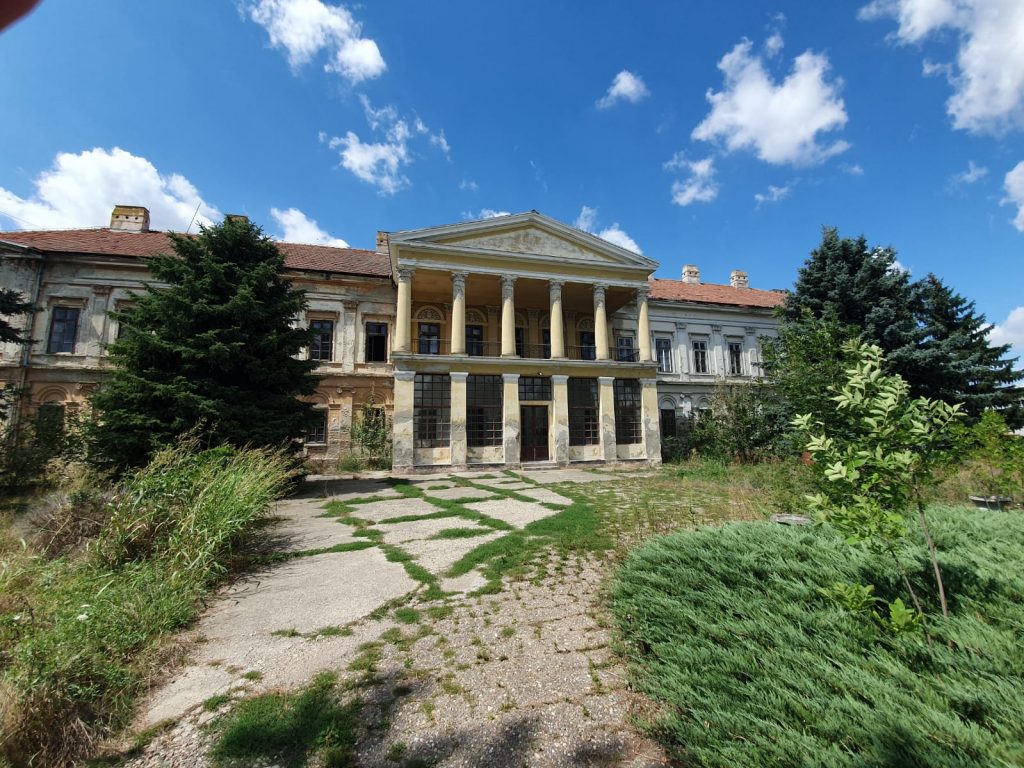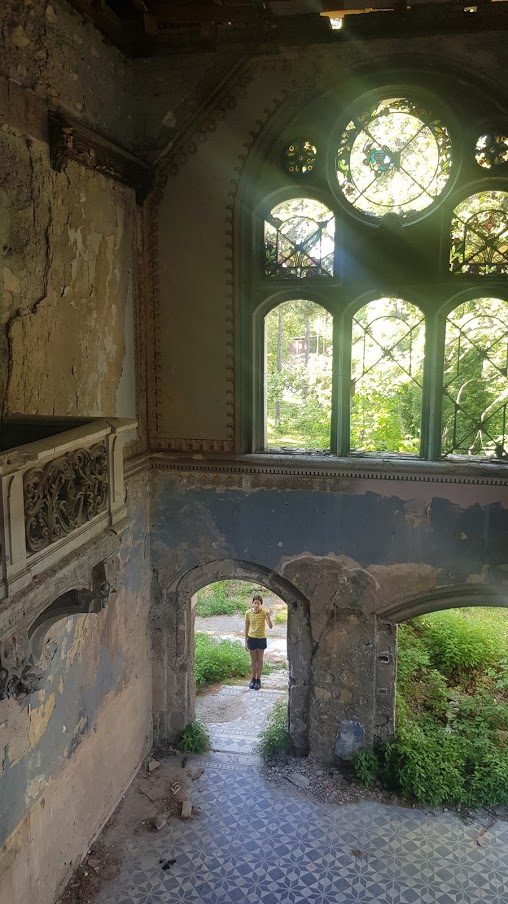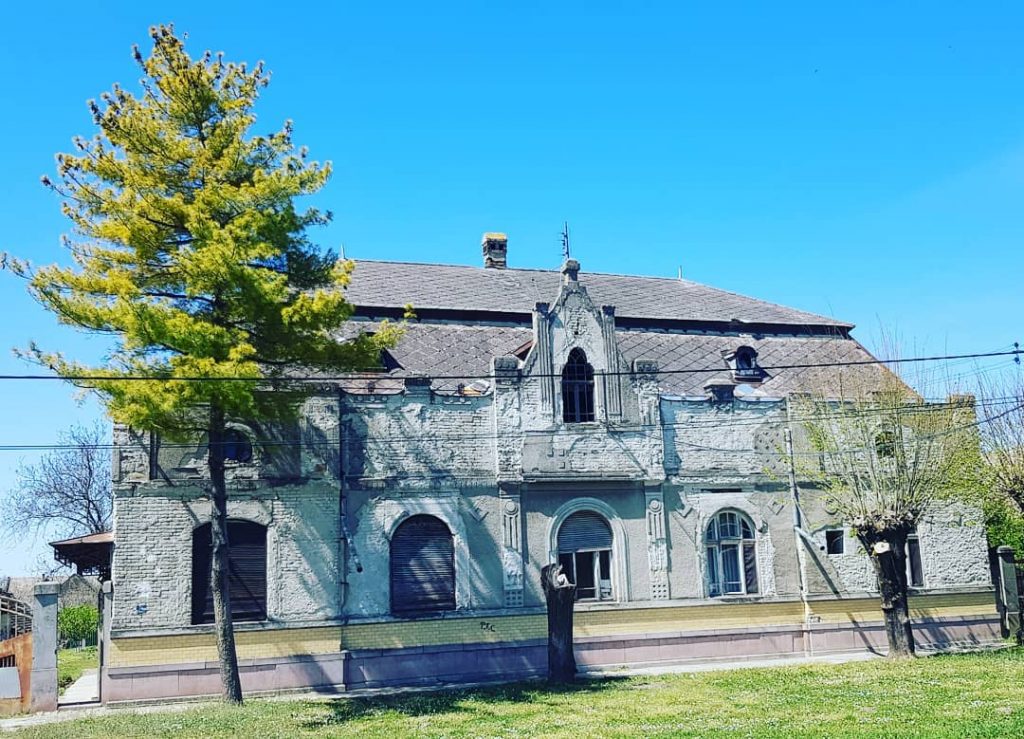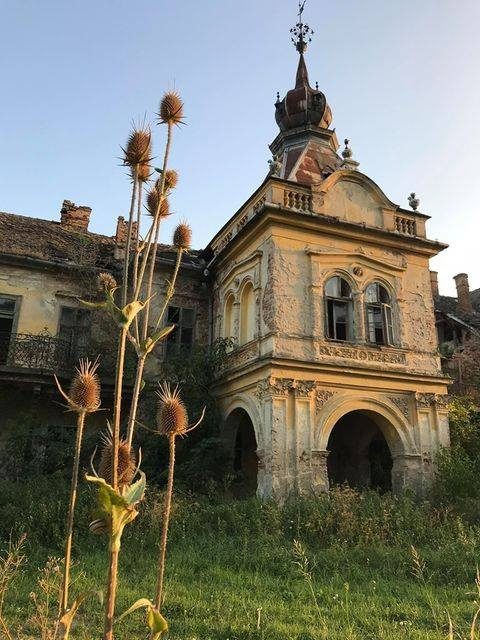The problem of dozens of abandoned and devastated castles should be solved by the Republic of Serbia or the Province of Vojvodina making a clear decision to give all these neglected beauties a new purpose after restoration because local governments usually have neither the will nor the means to solve complicated legal and property issues that are in the background of almost every case.

The raft that transports passengers from Futog to Beočin docks on the Srem side of the Danube and in front of us is a town that cries out for a Truman Capote-like description. From the devastated buildings in the port, the road leads me to the centre of the place. On the right side there is a cement factory which has several buildings of valuable historical heritage, also neglected. Through the tall vegetation, I enter the former Post Office building, a ruined Art Nouveau beauty that today stands empty with documents scattered on the floor from several decades ago when telegrams and letters were still sorted out here. On the left is a typical working class neighbourhood, next to the one in Vrdnik, which was built for miners – one of the most valuable examples of the architecture of organized workers’ housing from the early 20th century.
120 years ago, the owners of the Vrdnik mine and the Beočin cement plant paid more attention to the housing style of their workers than rich entrepreneurs and the transition winners do in their mansions today. The goal of the bicycle tour to Beočin was to see the famous Spitzer Castle, built in 1898 for a family of rich German landowners who were one of the owners of the Beočin Cement Plant. The building was designed in the eclectic style by the architect Imre Steindl (also the designer of the famous Hungarian Parliament Building in Budapest), and the castle has noticeable elements of both the old styles (such as Romanesque, Gothic, Renaissance and Baroque) and a modern one, Art Nouveau. The castle’s interior reflects the spirit of the variant of the Hungarian secession and was designed a little later. The central hall is the most valuable segment of the interior. At the same time when the castle was built, a large park was also built around it.
The Spitzer family left Beočin before the beginning of the Second World War, and during the war, the castle was used as a building of the German military command, only to be nationalized after the war ended. After that, it was used as a town library, a culture centre, the headquarters of the handball club, a radio station, a home for disabled persons and finally, an exclusive restaurant with accommodation. After the privatization of the Podunavlje Company, which was in charge of the castle’s management, the building was abandoned and has been quickly deteriorating since then. Our famous poet Mika Antić used a part of the castle as his painting studio. Today, almost all the windows on it are broken, and due to heavy rainfall in the winter of 2011, part of the entrance porch collapsed. By the way, the building was declared a cultural monument in 1997.
“HERITAGE WITHOUT PROTECTION” – THROUGHOUT THE COUNTRY
I went on a series of bicycle tours in Vojvodina in the spring to compensate for the foreign travel ban. The biggest impression I got from these short trips was that, according to some unwritten rule, the most beautiful houses, palaces, summer houses and castles everywhere I went were in the worst possible condition. The extent of negligence towards some of the most valuable objects of cultural and industrial heritage in our country is almost striking. While visiting other parts of Serbia I saw that the same attitude towards heritage prevailed in the entire country. In mid-September, we opened the Facebook page “Heritage without Protection” and invited people in Serbia to send examples of neglected heritage from their communities. So far, we have received more than 100 photo albums of facilities from all over the country that are in a state of partial or complete devastation.
The problem these castles should be solved by the Republic of Serbia or the Province of Vojvodina making a clear decision to give all these neglected beauties a new purpose after restoration because local governments usually have neither the will nor the means to solve complicated legal and property issues that are in the background of almost every case.

In addition to the Spitzer Castle described above, I had the opportunity to see the Karácsonyi Castle in Novi Miloševo, the largest in Vojvodina, which a colleague of mine Zlatko Crnogorac wrote about in this weekly a few months ago, after I drew his attention to this unutilized resource.
Another ruined castle is located in the village of Jarkovac in Srem. This summer house was built in the second half of the 19th century, when the Ruma manor was managed by Count Petar Pejačević and his son Adolf. The manor house was built on a hill with a beautiful view of the surrounding area. After the post-war nationalization, it was used as a local elementary school and nursery. Today it is almost completely devastated.
The castle of the Dundjerski family in Čelarevo, built in 1837, was the biggest landmark in the area before the Second World War. According to the list of confiscated property, the Dundjerski heirs did not ask for the castle to be returned to them. Gideon, the son of Lazar Dundjerski, wanted to give the castle and all its artwork to the people and to turn this architecturally significant building into a museum. That happened in 1968 and the castle now belongs to the Museum of Vojvodina. In the meantime, the facade was restored by the Carlsberg brewery, which has its headquarters in Čelarevo, but the castle is still empty and abandoned and the walls are covered in graffiti.
PIN’S VILLA – “THE MUSEUM OF DESTRUCTION”
In the very heart of Zrenjanin, stands once the magnificent Pin’s Villa, which was designed in the style of romanticism in 1894 by the architect Laszlo Gyalus for Leon Stegelwald, and two years later by Ferenc Daniel, who owned it until 1919. Paja Pin, a surveyor by profession, became its new owner in 1928. Although the villa has changed hundreds of tenants since 1943, when the Germans evicted the Pins, it is still remembered as the property of the Pin family.
The villa has been abandoned for decades and is in critical condition. It was conceived as a residential building with a clear division into a larger, residential part and service space, which are clearly recognizable both in appearance and interior. The interior, which used to speak about the high social status of its first owner considering the building materials used and the details, has been completely destroyed today. The lavish wooden steps that led from the spacious entrance hall to the first floor of the villa no longer exist. The parquet floor was destroyed, as well as other details of the interior, among them monuments to the craftsmen of that time. The project stipulating renovation of the facade of Pin’s Villa was drafted by the Institute for the Protection of Cultural Monuments from Zrenjanin back in 2005.
To this day, and despite several announcements, nothing has happened. As a sign of protest, local artists set up the Museum of Destruction in the Villa.
Not far from the Danube bank in Sremska Kamenica lies a castle that was originally owned by the Marczibanyi family. It was built in the late 18th and early 19th century. The castle was extended and reconstructed thanks to the new owners, the Karácsonyi family, in the middle of the 19th century. The building is a representative of the Classicist style, with colonnades of Doric pillars and wrought iron ornaments. The entire facility consists of four buildings, and is surrounded by an English landscape garden, originally decorated with exotic trees from around the world and sculptures of sphinxes and lions. The park had hiking and riding trails and a stocked lake. The remains of sculptures and the former garden are still there today.
Up until 1918, the wealthy the Karácsonyi family held balls and receptions in their castle. However, after the war, this magnificent building was nationalized and used for various purposes. Today, the castle is owned by the City of Novi Sad, and it houses two offices of the public enterprise Vode Vojvodine, and, except for graffiti and sculptures in the park, which were mostly destroyed and broken, it is solidly preserved. The Kamenica Park itself was renovated a year ago, and new benches, gazebos, training grounds, hiking and cycling trails, children’s game rooms and solar power lighting were added.
RUSSIAN PRINCE’S SUMMER HOUSE NEAR KIKINDA
Only two kilometres away from the famous Fantast castle, near Topolski Road, abandoned and left to the ravages of time, in the middle of a fertile plain, stands the Gombos family summer house. The owner of the estate, Deze Gombos, a lawyer from a noble family dating back to the 13th century, left for Hungary with his wife Zsuzsanna Galambos in 1944. The house, located in the centre of Bečej, is today used by the Automobile and Motor Association of Serbia, the afore-mentioned summer house, the land and the abundant collection of books written in five languages, which for the most part was not preserved and which remnant is in the National Library of Bečej, was left behind by the couple who spent their last days in Budapest. After the death of her husband in 1950, Zsuzsanna Galambos made living from manual labour. They left no heirs behind. Little is known about Deze and Zsuzsanna, but the photographs testify that they were important public figures in Bečej. It is interesting to note that this aristocrat is also the founder of the first tennis club in Bečej, one of the oldest in this area.

The magnificent building in the heart of Vojvodina, in which people from Bečej are becoming increasingly interested thanks to the enthusiasts who discovered this neglected gem, served as a home for the elderly from 1950 to 1960. Surrounded by ivy, near the fountain in the shape of a bust of a young woman, looking at its façade, this neglected building could, providing effort and money is invested, become unique tourist potential of the municipality of Bečej. By the way, the portrait of Deza Gombos, painted in the 1930s, now hangs on a wall of the ceremonial hall in the municipal building. The painting’s author is unknown, but it is assumed that it was a court painter from the Netherlands who stayed in Bečej for several years, on the Gombos family’s property, on Topolski Road.
There is a long list of castles in Vojvodina that are in this kind of or even worse condition. One of them is the Mavrokordato summer house near Kikinda, of which only a few pillars remain. It was built by a Russian prince of Greek origin, Georgije Dimitrijević Mavrokordato, who was born in Odessa in 1881, in a wealthy and infamous Mavrokordato family. His house, which I wrote about in my travelogue from Odessa for Vreme weekly in June last year, is known as the building with the longest balcony in the world.
There is also the Castle of Gedeon Rohonczy on the Pearl Island on the Tisza River; the Bisinger Castle in Vlajkovac in Banat; the Hristić-Fritz Castle in Bačko Novo Selo, two Art Nouveau palaces in Savino Selo and hundreds of castles, palaces, windmills, old factories, birthplaces of celebrities but also ordinary houses of great architectural value that are only on paper under state protection but in reality, they are not. Ruined Protestant and Catholic churches in places where Germans lived until 1944 are a special topic. Except for a handful of cases (in Apatin, Odžaci, etc.), these are ghostly buildings that stand in town and village centres. Nobody is willing to renovate or demolish them.

In April 2016, I wrote an article for Vreme weekly about the thatched roof houses in Novi Sad’s neighbourhood of Rotkvarija, which were deliberately neglected in order to be stripped off their protection status. Later, they were demolished and the controversial real estate developer, Galens, built there a residential quarter called Kraljev Park. There are many examples in Central Serbia too, such as the Čavić House in the centre of Novi Pazar or the Town Hall in Valjevo, but we’ll talk about them on a different occasion.
BABA PUSZTA – “THE ANGKOR WAT OF VOJVODINA”
Finally, here’s the story about one of the most picturesque castles in our country – the summer house Baba Puszta, once owned by the nobleman Karoly Fernbach. The castle is located 9 kilometres from the village of Aleksa Šantić (Šari), in Bačka district, not far from the border with Hungary and out of all the summer houses and palaces in Vojvodina, it perhaps reminds the most of the Transylvania castles. It was built in 1907 and designed by the Hungarian architect Rezső Hikisch.
It was, after Fantast, the most impressive castle in Vojvodina, but after the Second World War, it was the seat of the Aleksa Šantić agricultural cooperative. Although it served other purposes it remains one of the most powerful-looking castles.
During the 1990, the cooperative collapsed and the building was left to ruin. It became a gathering place for drug addicts and overgrown with vegetation. Back in 2009 and 2011, reports show a castle that had no roof, but it is clearly visible. Today, it is not visible from the overgrown bushes, the chapel with frescoes was destroyed, the frescoes were torn down, and the marble altar was broken into two parts by hooligans because they were told that there was gold under it. There was no gold, of course.
While putting together the edition “Hello! Travel: Sombor and Apatin”, our journalist Žikica Milošević visited Baba Puszta and shared his impressions: “The castle today looks like from an Indiana Jones movie. In just 10 years, the vegetation has swallowed the castle, so it’s no wonder they’ve never found lost Latin American cities like Eldorado. The scene is more reminiscent of Angkor Wat or Palenque.”
Several people live in close proximity to the castle. Szandor, once employed in the castle, says in nostalgic voice: “Life in Vojvodina used to be beautiful”.
A joint commission of the two ministries
Following the initiative of Robert Čoban, the Ministry of Culture and Information and the Ministry of Construction, Transport and Infrastructure launched an initiative to establish a joint commission whose members, in addition to representatives of the two ministries, would be the representatives of the Institute for the Protection of Cultural Monuments of Serbia, the Institute for the Protection of Cultural Monuments of Vojvodina and the Foundation for Cultural and Industrial Heritage. The goal of this commission is to make a list of castles, summer houses and villas of cultural and historical significance on the territory of the Republic of Serbia and to investigate who owns them. After that, the castles will be renovated and will be used as tourist attractions and locations for the film industry.
By Robert Čoban
Photo credits: Mladen Sekulić and Robert Čoban